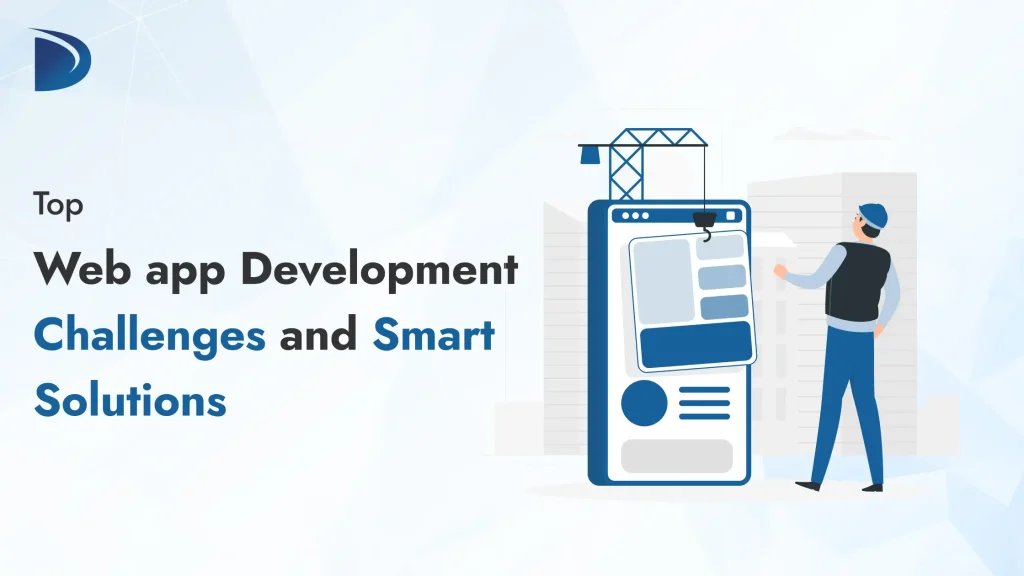Table of Contents
What is Web app development?
Web app development involves creating, building, and maintaining websites or web applications that operate on the internet. It combines programming, design, and problem-solving to deliver functional and visually appealing web solutions.
Why is Web app development important?
1. Online Presence:
Websites are essential for reaching customers who are likely to purchase products or services from a business. A strong, well-designed website enhances brand visibility and credibility.
2. User Experience:
Effective web application development ensures that websites are intuitive, easy to navigate, and responsive across devices, providing a seamless user experience.
3. Business Growth:
Thus, website development supports e-commerce activities, marketing, and customer support to drive sales, increase brand awareness, and improve customer retention.
4. Adaptation to New Technologies:
Web app development involves advancements in AI, machine learning, and IoT, which are the latest strategies companies use to stay ahead in a rapidly changing digital environment.
Web Development Challenges and Their Solutions
Web app development challenges can affect project timelines, user experience, and overall success. Establishing a strong online presence is essential, but it also brings inherent challenges. This article examines common daily web app development challenges and offers practical solutions to overcome them.
Whether you are a developer, business owner, or project manager, understanding these challenges and solutions can help ensure smooth project execution.
Challenge 1: Meeting Client Expectations
Clients may have high and unrealistic expectations and may not fully understand the dynamics of web app development. Misinterpretation of communication often leads to missed targets or frequent changes.
Solutions:
- Arrange initial meetings to discuss project specifications, deadlines, and deliverables to ensure clear communication.
- Use mockups or wireframes to illustrate website structure and functionality.
- Set up frequent checkpoints and milestone reports to keep clients informed and updated on progress.
Challenge 2: Managing Project Timelines
In reality, many projects are delayed at some stage due to unclear requirements, scope creep, and unforeseen technical problems.
Solution:
- Define a Scope of Work: Clearly outline the project scope to prevent last-minute changes.
- Utilize project management tools, such as Trello, to manage tasks and deadlines effectively.
- Agile Method: Instead of breaking down work requirements into oversized packages, make the project manageable by splitting it into several short sprints in which portions of features are incrementally developed.
Challenge 3: Ensuring Responsive Design
Creating a high-performing website that functions seamlessly across different devices and screen sizes can be challenging.
Solution:
- Consider small screens (such as mobile devices) first, before scaling to larger sizes.
- Tools like BrowserStack or Responsinator are suitable for testing your website on different devices.
- Fluid grids and scalable images can be implemented with CSS frameworks such as Bootstrap or Tailwind CSS.
Challenge 4: Website Security
Websites are never immune to the risk of cyberattacks, whether through hacking, data breaches, or malware injection.
Solution:
- Authentication with HTTPS (SSL certificates) should be configured to ensure all data is secure.
- Regularly update all software, plugins, and frameworks to close security loopholes.
- Implement web application firewalls (WAFs) to filter and monitor traffic.
- Regularly back up all website data for easy recovery in the event of an attack.
Challenge 5: Optimizing Website Speed
Slow websites provide a poor user experience and increase the bounce rate, which directly affects the website’s search engine ranking.
Solution:
- Reduce image sizes using tools such as TinyPNG or ImageOptim without compromising quality.
- Remove unnecessary characters from CSS, JavaScript, and HTML files by minifying code.
- Use a Content Delivery Network (CDN) to distribute content across multiple servers and reduce latency.
- Load images and other elements only when they appear in the user’s viewport.
Challenge 6: Cross-Browser Compatibility
Different browsers may display websites differently, resulting in inconsistent user experiences.
Solution:
- Follow the web standards established by the World Wide Web Consortium (W3C) for standard web development practices and coding conventions.
- Use CrossBrowserTesting or LambdaTest to test and identify where compatibility breaks down.
- Ensure that the core functionality works with older browser versions.
Challenge 7: Integrating Third-Party APIs
APIs can be unpredictable, with issues such as downtime, limited documentation, or unexpected changes without notice.
Solution:
- Choose reliable APIs with comprehensive documentation and robust support.
- Implement robust error-handling mechanisms to manage API failures effectively and efficiently.
- Use API monitoring services to track performance and uptime.
Challenge 8: Maintaining Scalability
As businesses grow, challenges in website development increase; websites must handle increased traffic, larger databases, and additional functionalities.
Solution:
- Design websites for scalability using frameworks that support growth.
- Distribute traffic across multiple servers to ensure reliability.
- Use scalable cloud solutions such as AWS, Azure, or Google Cloud.
Challenge 9: Accessibility Compliance
Making a website user-friendly is a complex task for users with disabilities. However, it is a matter of social importance and legal obligation.
Solution:
- Follow the Web Content Accessibility Guidelines (WCAG) for design and content.
- Add Accessible Rich Internet Applications (ARIA) roles to improve compatibility with screen readers.
- Test accessibility using WAVE or Axe web testing tools to evaluate your website’s accessibility.
Challenge 10: Continuous Maintenance and Updates
After launching a website, maintaining its functionality and keeping it updated are ongoing challenges.
Solution:
- Use tools such as Google Analytics, Search Console, or others to track and monitor performance regularly.
- Frequently update content to keep it relevant and engaging.
- Fix bugs and technical issues promptly to ensure smooth functionality.
What is the Most Challenging Part of Being a Web Developer?
- Staying updated with new technologies and frameworks.
- Balancing speed with maintaining high-quality code.
- Managing client expectations regarding timelines, functionality, and design.
- Ensuring that a website works consistently across all browsers and devices.
Conclusion
Web app development challenges are inevitable, but with foresight, the right strategy, and careful planning, they can be overcome. Emphasizing communication, using modern tools, and following best practices help developers and businesses create websites that effectively serve users and stand out in online competition. Whether starting a new project or improving an existing one, addressing these web development challenges can lead to success.
FAQs
What are the most common web app development challenges for beginners?
Some common challenges for beginners in web app development include managing client expectations, ensuring website security, optimizing website speed, achieving cross-browser compatibility, and ensuring scalability.
How can I ensure my website is secure?
This is one of the challenges web developers face. To ensure site security, use an SSL certificate, build a firewall, regularly update software versions, and maintain data backups.
Which tools can be used for responsive designs?
Tools such as BrowserStack and Responsinator, as well as frameworks like Bootstrap and Tailwind CSS, can help create responsive websites.
Why is speed important to websites?
A faster-loading website enhances the user’s overall experience, reduces bounce rates, and improves search engine rankings.
How do I handle issues related to API integration?
Choose a reliable API, implement error handling, and monitor API performance using tools such as Postman or API Fortress.
What is the best way to ensure accessibility compliance?
Follow WCAG guidelines, use ARIA roles, and test the site with accessibility tools such as WAVE or Axe to help ensure compliance.
How often should we update the website?
Regularly updating websites helps fix bugs, improve performance, and refresh content to remain relevant.

